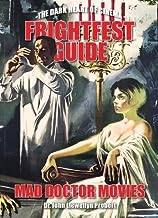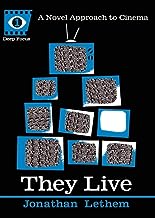 |
| The Frightfest Guide To Mad Doctor Movies |
The Frightfest Guide To Mad Doctor Movies, by Dr. John Llewellyn Probert, ISBN-10 1913051323, ISBN-13 978-1913051327, RRP £19.99
The Frightfest Guide to Mad Doctor Movies is the seventh in FAB Press' collection. Written by Dr. John Llewellyn Probert, whose professional expertise as a urologist, novelist and film writer further extends to his work with wife (and fellow author) Kate/Thana Niveau as lost film condensed version stage-recreators Teatro Proberto. If that seems quite a lot it's indicative of the feel of the book, which continually finds ways to add a little bit more.
There's a foreword by Frightfest architect Alan Jones, who's penned two of the Frightfest Guides himself. There's also a foreword by The Human Centipede's Tom Six. After the authorial introduction, those two forewords, Probert gives us a whistlestop tour around the somewhat plastic collection of Mad Doctor movies. This sometimes strays into Mad Scientist territory, as the definition used broadly includes those in "possession of a medical degree, or those who have gained a doctorate in another subject but whose work has led to horrific consequences for other human beings... A few supremely unqualified but enthusiastic amateurs have also been included in the mix."
Among the various medical specialists are a couple of physicists, including some of the 66 mentions of Cronenberg (Senior and Junior) for The Fly and Bond's first foe, Dr. No. Those enthusiastic amateurs include a phalanx of Frankensteins, who must be regarded only as an honorary doctor despite having had two centuries and change to complete his undergraduate studies. There's some measure of medical terminology, including discussions of staple pituitary condition acromegaly, notionally associated with gigantism and though explained more fully on p71 never covered to any great scale.
Probert's tone is entertaining, there is a very particular pedantry I enjoy and I laughed out loud several times, including a discussion of Udo Keir's organ on organ issues.
That pedantry sometimes works against it. I remain of the opinion that as it has more than one set of limbs per segment the eponymous construct is in fact a human (if not man-made) millipede. Elsewhere there's an assertion that 1946's The Face Of Marble has "the last mad doctor of the 1940s" but 1948's Sinister House probably counts. Its original title of Who Killed 'Doc' Robbin? conceals an attempt to resurrect the Little Rascals by Hal Roach, within it further concealed a doctor and a basement with a gorilla that may or may not have someone else's brain.
There's a suggestion on page 27 that "head transplantation" is not a field of research. It is, and frequently in the headlines, but not an entirely credible one. Sergio Canavero's actually less interesting on the subject than his critic Dean Burnett. To quote the latter "Give me 5 minutes and a staple gun and I'll give you the same results".
While it does mention films from several countries, including Japan, there are some gaps in its exclusions. It mentions Biohazard 4D-Executor but by that measure there should be mention of any of the rest of the Resident Evil series. Other references not made include shrink-process wielding Dr Cyclops where one could talk about Downsizing. That's in contrast to process-wielding shrink Dr Lecter (and Lektor!) for a discussion of Thomas Harris' Hannibal. Among other mad doctors not mentioned is an opportunity to extend the theme of Nazi super(natural) size in the discussion of Tusk to mention Yoga Hosers. Admittedly, not many people have seen the latter, and being among them I wish I wasn't.
Like all the Frightfest Guides there will be films you've heard of, opinions on some of those you may not agree with, and pictures you've never seen that you'll want to track down. Some of the inclusions might have more to do with proximity to Frightfest than others, fond as I am of Leigh Whannel's Upgrade the boundaries of 'mad doctoring' that include it should catch plenty of others, including Robocop and Face/Off. There are references to other films covered in other Frightfest Guides as well,
The films themselves run from page 40 to 237, from 1920 to 2022, from Dr. Caligari (psychiatry?) to Dr. Morbius (haematology). With full colour throughout it has posters, stills, and in some copies there may be an electrical buzzer system. I think getting a preview copy on PDF may have saved me from any associated shocks, but I cannot warrant that hard copies would be so secured. Having read past Frightfest Guides in the flesh (so to speak) I expect reasonable heft to go with their weighty contents, and Fab Press have hardback copies available if your film library has room.
The Frightfest Guides are speaking mostly to fans, and that's fine. They do serve as a reasonable introduction to genre, and Probert's an entertaining voice talking us through it. Genre boundaries are never clear, indeed the flexible appearance of features and symptoms dismay taxonomists and diagnosticians alike. The index covers somewhere north of 700 films (and TV series) and while two hundred and twenty three (by my count) are discussed across most of a page there are allusions and references everywhere. Some names crop up again and again, Cronenberg is one, but Terence Fisher makes it to double digits too.
Anyone who is a fan of horror as a genre will find something here to enjoy, but completists beware - so many of these mad doctors find themselves obsessively pursuing resources for their projects. There are only a couple of hundred bones in a human adult. Those are much easier to store than an equivalent volume of DVDs, though a very different challenge to alphabetise. Though Probert makes a good case for most inclusion in his list of mad doctors many of them are more even less diligent with their paperwork than they are with ethical concerns. I have fewer issues recommending this guide.
 |
| They Live (Deep Focus): A Novel Approach To Cinema |
They Live (Deep Focus): A Novel Approach To Cinema, by Sean Howe & Jonathan Lethem, Soft Skull Press, ISBN-10 : 159376278X, ISBN-13 : 978-1593762780, RRP £10.90
It's a source of some sadness to discover after reading They Live that there are only five in Soft Skull's 'Deep Focus' series. This is, was, the first of them, a deep dive into John Carpenter's They Live. It is written by Jonathan Lethem, a novelist whose own Motherless Brooklyn was adapted to film in 2019.
The text opens with six notes, closes with unnumbered footnotes, and in the middle runs through scene by scene, sometimes second by second. It's annotations to a text in a different medium, a parallel commentary where all the parallel is provided by the reader. One could argue that it could be played in unison like a DVD extra but I don't know if you'd need special glasses to manage it.
The format feels pulpy, the cover design by Spacesick doesn't look out of place among my legions of 1970s science fiction paperbacks. That's consistent across the range, which includes Death Wish and The Sting as well as Heathers. The other one is Bad News Bears Breaking Training, and even knowing that exists I'm trying to track down a copy of them all. It's dimensionally odd, closer to a Blu-Ray or a dime-store novel than any A- or B- format paperback. The size of them is a bit of a rabbit hole but in truth given that my film book shelves contain some of the tallest and thickest tomes in my library a bit of aspect ratio confusion isn't news.
I don't want to spend several minutes beating you up to try and get you to look at this, but I think it's important. Lethem's sanguine about what he describes as the films "zones of lively incoherence" and that mixed bag of features is one of the things that makes it so readable. That's both as Lethem's text, it made an otherwise tedious train journey whip by, but also a film. There's so much and so little of They Live as a film that there are all manner of spaces to interpret. Roddie Piper's skills as an actor, elements of political positions, Carpenter's obsessions as an auteur and multi-hyphenate.
At its best, criticism follows the rules I set for documentary. An interesting subject explored in an interesting way. Novel-length criticism (176 pages!) is an incredible notion, it's not a review, it's not an essay, it's an exploration and guide and glorious. They Live, about They Live, does all of this.
Chapter headings like "Grocery Store" or "Gay Porn" or "The Futility of Collective Action" are concrete poetics in an examination of a film that is itself about ways of seeing. That the text is now a decade old, that there's been subsequent scholarship does not reduce its impact. I still like to look at old maps, to know how different then was the territory. I would hesitate to recommend it to anyone who did not already know They Live, but anyone whose eyes had been opened by that work should have their eyes pointed at this. I can't say what it would be like to read this having not seen the film, but if I can find an appropriate subject I might give it to them. If they're really lucky I won't punch them first.





















